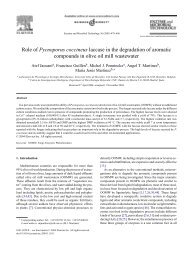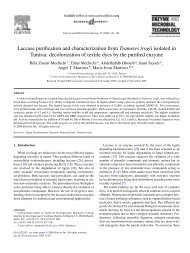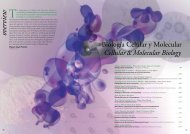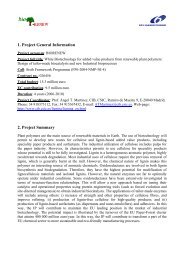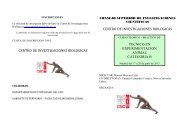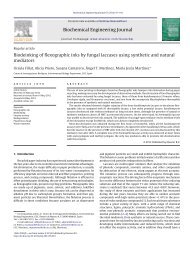03 Medicina Celular y Molecular.pdf 5474KB May - Centro de ...
03 Medicina Celular y Molecular.pdf 5474KB May - Centro de ...
03 Medicina Celular y Molecular.pdf 5474KB May - Centro de ...
Create successful ePaper yourself
Turn your PDF publications into a flip-book with our unique Google optimized e-Paper software.
<strong>Medicina</strong> <strong>Celular</strong> y <strong>Molecular</strong> | Cellular and <strong>Molecular</strong> Medicine<br />
76<br />
santiago rodríguez <strong>de</strong> Córdoba<br />
Profesor <strong>de</strong> Investigación | sr<strong>de</strong>cordoba@cib.csic.es<br />
Patología <strong>Molecular</strong> / Genética <strong>de</strong>l Complemento<br />
Tras i<strong>de</strong>ntificar varios genes causantes<br />
<strong>de</strong> enfermeda<strong>de</strong>s, nuestro trabajo<br />
actual se centra en:<br />
Complemento y enfermedad. El<br />
complemento es esencial en la inmunidad<br />
innata con papeles fundamentales en la<br />
infección, la eliminación <strong>de</strong> restos celulares<br />
y complejos inmunes y la modulación <strong>de</strong> la<br />
inmunidad adquirida. Sin embargo, es una<br />
espada <strong>de</strong> doble filo ya que su activación<br />
<strong>de</strong>scontrolada se asocia con muchas<br />
enfermeda<strong>de</strong>s. La manera exacta por la<br />
que el complemento cambia <strong>de</strong> proteger<br />
a <strong>de</strong>struir no se entien<strong>de</strong> totalmente. Para<br />
compren<strong>de</strong>rlo estamos caracterizando las<br />
PhD, 1981.<br />
Hospital Ramón y Cajal, UCM.<br />
Visiting Scientist 1981,<br />
Associate Investigator 1985.<br />
The New York Blood Center, NY, USA.<br />
Científico Titular, 1986,<br />
Incorporación CIB, 1989,<br />
Investigador Científico, 1990.<br />
CIB, CSIC.<br />
Director Unidad <strong>de</strong> Patología <strong>Molecular</strong>, 1996-2002.<br />
Fundación Jiménez Díaz, Madrid.<br />
Profesor <strong>de</strong> Investigación, 2000.<br />
CIB, CSIC.<br />
Utilizamos técnicas genómicas y <strong>de</strong> biología molecular<br />
con el objetivo <strong>de</strong> <strong>de</strong>scifrar las bases moleculares <strong>de</strong><br />
enfermeda<strong>de</strong>s humanas. Nuestra actividad incluye<br />
i<strong>de</strong>ntificar los genes que las causan y caracterizar<br />
funcionalmente sus variantes patogénicas mediante<br />
consecuencias funcionales <strong>de</strong> variaciones<br />
genéticas <strong>de</strong> los genes <strong>de</strong>l complemento<br />
asociados al síndrome hemolítico urémico<br />
atípico, a la enfermedad por <strong>de</strong>pósitos<br />
<strong>de</strong>nsos y a la <strong>de</strong>generación macular asociada<br />
a la edad.<br />
Enfermedad <strong>de</strong> Lafora (LD). LD es una<br />
enfermedad neuro<strong>de</strong>generativa fatal y la<br />
causa más frecuente <strong>de</strong> epilepsia progresiva<br />
mioclónica en Europa meridional. Dos<br />
genes causan LD, EPM2A, que codifica una<br />
tirosina-fosfatasa dual <strong>de</strong>nominada laforina<br />
y EPM2B, que codifica una E3-ubicuitina<br />
ligasa llamada malina. Después <strong>de</strong> “clonar”<br />
el gen EPM2A y mostrar que laforina<br />
Otros miembros | Other lab members:<br />
Tamara Montes Fernán<strong>de</strong>z<br />
Silvana Mouron<br />
Arturo Jiménez Periañez<br />
Rubén Martínez Barricarte<br />
Agustín Tortajada Alonso<br />
Olga Criado García<br />
Sheila Pinto García<br />
Ángela Ruiz Sánchez<br />
www.cib.csic.es/es/grupo.php?idgrupo=21<br />
Laura Blanco Sobero<br />
Javier Gayarre Navarro<br />
Lara Durán Trío<br />
Sonia Alejo Martín<br />
el análisis bioquímico, celular y estructural <strong>de</strong><br />
las proteínas que codifican. A<strong>de</strong>más, generamos<br />
mo<strong>de</strong>los in vitro e in vivo <strong>de</strong> estas enfermeda<strong>de</strong>s con<br />
el objetivo <strong>de</strong> enten<strong>de</strong>r los mecanismos patogénicos<br />
y <strong>de</strong>sarrollar estrategias diagnósticas y terapéuticas.<br />
interacciona con proteínas <strong>de</strong>l metabolismo<br />
<strong>de</strong>l glucógeno, hemos <strong>de</strong>mostrado<br />
que el complejo laforina-malina regula<br />
la síntesis <strong>de</strong>l glucógeno a través <strong>de</strong> la<br />
ubicuitinilación y <strong>de</strong>gradación proteosomal<br />
<strong>de</strong> glucógeno Sintasa y <strong>de</strong> PTG. También<br />
hemos <strong>de</strong>mostrado que laforina juega un<br />
papel en autofagia. Usando una colección<br />
<strong>de</strong> mo<strong>de</strong>los animales generados en<br />
el laboratorio estamos <strong>de</strong>scifrando los<br />
mecanismos patogénicos <strong>de</strong> la LD.<br />
Transferencia <strong>de</strong> tecnología. Hemos<br />
generado una compañía spin-off <strong>de</strong>l CIB<br />
(www.secugen.es) <strong>de</strong>dicada a secuenciación<br />
<strong>de</strong> DNA y diagnóstico molecular.<br />
La figura muestra el árbol genealógico <strong>de</strong>l primer caso <strong>de</strong> enfermedad<br />
por <strong>de</strong>pósitos <strong>de</strong>nsos (EDD) <strong>de</strong>bido a una mutación en el gen <strong>de</strong> C3.<br />
La caracterización funcional <strong>de</strong> esta mutación ha aportado pruebas<br />
concluyentes en humanos indicando que la <strong>de</strong>sregulación <strong>de</strong>l complemento<br />
en plasma, con la generación continua <strong>de</strong> C3b, juega un papel importante<br />
en la patogénesis <strong>de</strong> EDD. El análisis <strong>de</strong> esta excepcional mutación ha<br />
mostrado a<strong>de</strong>más algunos <strong>de</strong> los requisitos estructurales que subyacen en<br />
el reconocimiento <strong>de</strong>l sustrato y a los mecanismos <strong>de</strong> regulación por fH, DAF<br />
y MCP, aumentando nuestro conocimiento <strong>de</strong> la activación y la regulación<br />
<strong>de</strong> la convertasa <strong>de</strong>l C3 <strong>de</strong> la vía alternativa (Véase Martínez-Barricarte et al.,<br />
J Clin Invest. 120:3702-3712 (2010) para más <strong>de</strong>talles).<br />
The figure shows the pedigree of the first case of <strong>de</strong>nse <strong>de</strong>posit disease<br />
(DDD) due to a mutation in the C3 gene. The functional characterization of<br />
this mutation provi<strong>de</strong>d conclusive evi<strong>de</strong>nce in humans indicating that fluid<br />
phase-restricted AP dysregulation, resulting in the continuous generation of<br />
C3b in plasma, plays a major role in DDD pathogenesis. Furthermore, analysis<br />
of this exceptional C3 mutation illustrates some of the structural requirements<br />
un<strong>de</strong>rlying the substrate recognition and regulatory activities of fH, DAF and<br />
MCP, advancing our un<strong>de</strong>rstanding of the activation and regulation of the<br />
AP C3 convertase. See Martínez-Barricarte et al., J Clin Invest. 120:3702-3712<br />
(2010) for <strong>de</strong>tails.<br />
<strong>Molecular</strong> Pathology /<br />
Complement Genetics<br />
We perform research in genomics and molecular genetics with<br />
a specific interest in the molecular bases of human disease.<br />
Our activities involve gene i<strong>de</strong>ntification, mutation <strong>de</strong>tection and<br />
biochemical, cellular and structural analysis of the proteins enco<strong>de</strong>d by<br />
the disease-associated genes. A major objective is generating in vitro and<br />
in vivo mo<strong>de</strong>ls to increase our un<strong>de</strong>rstanding of pathogenic mechanisms, to<br />
improve diagnostics and to <strong>de</strong>velop preventive and therapeutic strategies.<br />
After previous successes in mapping and i<strong>de</strong>ntifying various<br />
disease-causing genes our current work focused on:<br />
Disor<strong>de</strong>rs due to dysregulation of the complement system.<br />
Complement is central to innate immunity with roles in bacterial killing,<br />
apoptotic cell clearance, immune complex handling and modulating<br />
adaptive immunity. Complement is a double-edged sword, with<br />
uncontrolled activation contributing to pathology in many diseases.<br />
However, the precise way in which complement shifts from protective<br />
to <strong>de</strong>structive roles is not completely un<strong>de</strong>rstood. Using in vitro and<br />
in vivo mo<strong>de</strong>ls, we are currently addressing the study of the functional<br />
consequences of different genetic variations of the complement<br />
genes associated to atypical hemolytic uremic syndrome, <strong>de</strong>nse<br />
<strong>de</strong>posit disease and age-related macular <strong>de</strong>generation.<br />
Lafora Disease (LD). LD is a fatal neuro<strong>de</strong>generative disor<strong>de</strong>r and<br />
the most frequent cause of progressive myoclonus epilepsy in<br />
Southern Europe. Two genes cause LD, EPM2A encoding laforin, a<br />
dual protein tyrosine phosphatise and EPM2B encoding malin, a<br />
E3-ubiquiting ligase. We cloned EPM2A and later <strong>de</strong>monstrated that<br />
laforin interacts with proteins implicated in glycogen metabolism.<br />
Recently we showed that the complex formed by laforin and malin<br />
La figura muestra el análisis mediante microscopia confocal <strong>de</strong> las proteínas asociadas<br />
a los Cuerpos <strong>de</strong> Lafora (LB) en ratones Epm2B -/-, un mo<strong>de</strong>lo <strong>de</strong> Enfermedad <strong>de</strong><br />
Lafora. Los ratones Epm2B -/- presentan dos tipos <strong>de</strong> LBs, gran<strong>de</strong>s redondos y<br />
uniformes y pequeños e irregulares. La reconstrucción con imágenes seriadas <strong>de</strong><br />
los LBs en el tronco cerebral <strong>de</strong> estos ratones <strong>de</strong>muestra que los LBs irregulares<br />
pequeños se tiñen uniformemente para laforina y ubiquitina (A), tal vez sugiriendo<br />
un intento <strong>de</strong> eliminar los LBs en su etapa inicial <strong>de</strong> formación. La ubiquitina está<br />
ausente en los LBs gran<strong>de</strong>s don<strong>de</strong>, a<strong>de</strong>más <strong>de</strong> laforina, está presente la glucógeno<br />
sintasa (MGS) (B). En estos LBs, laforina se localiza predominantemente en el centro<br />
y MGS está en la superficie (C), lo que podría indicar que el glucógeno se acumula<br />
continuamente manteniendo estas estructuras en crecimiento.<br />
The figure shows the confocal microscope analysis of proteins associated with Lafora<br />
Bodies (LB) in the Epm2B-/- mouse, a mo<strong>de</strong>l of Lafora Disease. Epm2B-/- mice present<br />
two different types of LBs, big round uniform structures and small irregular ones. Confocal<br />
serial reconstruction of the LBs in the brainstem of these mice <strong>de</strong>monstrates that the<br />
small irregular LBs stain uniformly for laforin and ubiquitin (A), perhaps suggesting an<br />
attempt to eliminate the LBs at this early stage of formation. Ubiquitin is absent in the<br />
round LBs, where, in contrast skeletal muscle glycogen synthase (MGS) is present (B). In<br />
these LBs, laforin localizes predominantly at the core and MGS is in the surface (C), perhaps<br />
suggesting that glycogen is continuously accumulating in these growing structures.<br />
regulates glycogen metabolism<br />
by a novel mechanism involving<br />
the ubiquitinilation and proteosomal<br />
<strong>de</strong>gradation of GS and PTG proteins<br />
and have provi<strong>de</strong>d evi<strong>de</strong>nce that laforin<br />
has a role in autophagy. Using a collection<br />
of animal mo<strong>de</strong>ls generated in our lab we are<br />
currently exploring the pathogenic mechanisms<br />
un<strong>de</strong>rlying LD.<br />
Technology transfer. Our expertise in DNA<br />
sequencing and its applications contributed to<br />
generate a spin-off company in the CIB (www.secugen.es)<br />
<strong>de</strong>dicated to DNA sequencing and molecular diagnostics.<br />
Publicaciones Seleccionadas<br />
Selected Publications<br />
Martínez-Barricarte R.*, Heurich M.*, Val<strong>de</strong>s-Cañero F., Vázquez-Martul E.,<br />
Torreira E., Montes T., Tortajada A., Pinto S., López-Trascasa M., Morgan BP.,<br />
Llorca O., Harris CL. and Rodríguez <strong>de</strong> Córdoba S. Human C3 mutation<br />
reveals a mechanism of Dense Deposit Disease pathogenesis and provi<strong>de</strong>s<br />
insights into complement activation and regulation. J Clin Invest.<br />
120:3702-3712 (2010). (*Equal first author).<br />
Hakobyan S*, Tortajada A*, Harris CL, Rodríguez <strong>de</strong> Córdoba S and<br />
Morgan PB. Variant-specific quantification of factor H in plasma i<strong>de</strong>ntifies<br />
null alleles associated with atypical Hemolytic Uremic Syndrome. Kidney<br />
Int. 78:782-788 (2010). (*Equal first author).<br />
Rodríguez <strong>de</strong> Córdoba S. aHUS: a disor<strong>de</strong>r with many risk factors. Blood.<br />
115:158-160 (2010).<br />
Moreno-Navarrete JM, Martínez-Barricarte R, Catalán V, Sabater M, Gómez-<br />
Ambrosi J, Ortega FJ, Ricart W, Blüher M, Frühbeck G, Rodríguez <strong>de</strong> Córdoba<br />
S and Fernán<strong>de</strong>z-Real JM. Complement Factor H is expressed in adipose<br />
tissue in association with insulin resistance. Diabetes 59:200-9 (2010).<br />
Torreira E*, Tortajada A*, Montes T*, Rodríguez <strong>de</strong> Córdoba S (*#) and Llorca<br />
O (*#). Coexistence of closed and open conformations of complement factor<br />
B in the alternative pathway C3bB (Mg2+) proconvertase. J. Immunol.<br />
183:7347-7351 (2009) (*Equal first and last author, # correspon<strong>de</strong>nce author).<br />
Abarrategui-Garrido C*, Martínez Barricarte R*, López-Trascasa M,<br />
Rodríguez <strong>de</strong> Córdoba S and Sánchez-Corral P. Characterization of<br />
complement factor H-related (CFHR) proteins in plasma reveals novel<br />
genetic variations of CFHR1 associated with atypical Hemolytic Uremic<br />
Syndrome. Blood. 114: 4261-4271 (2009). (*Equal first author).<br />
Tortajada A, Montes T, Martínez-Barricarte R, Morgan PB, Harris CL and<br />
Rodríguez <strong>de</strong> Córdoba S. The disease-protective complement factor<br />
H allotypic variant Ile62 shows increased binding affinity for C3b and<br />
enhanced cofactor activity. Hum Mol Genet. 18:3452-61 (2009).<br />
Montes T, Tortajada A, Morgan BP, Rodríguez <strong>de</strong> Córdoba S and Harris CL.<br />
Functional basis of protection against age-related macular <strong>de</strong>generation<br />
conferred by a common polymorphism in complement factor B. Proc.<br />
Natl. Acad Sci USA. 106:4366-4371 (2009).<br />
Torreira E*, Tortajada A*, Montes T*, Rodríguez <strong>de</strong> Córdoba S (*#) and<br />
Llorca O (*#). 3D structure of the C3bB complex provi<strong>de</strong>s insights into<br />
the activation and regulation of the complement alternative pathway<br />
convertase. Proc. Natl. Acad Sci USA. 106:882-887 (2009). (*Equal first<br />
and last author, # correspon<strong>de</strong>nce author).<br />
Premio<br />
Award<br />
Premio Nacional <strong>de</strong> Genética por las contribuciones en investigación<br />
<strong>de</strong> la genética humana y sus aplicaciones (2009).<br />
77




